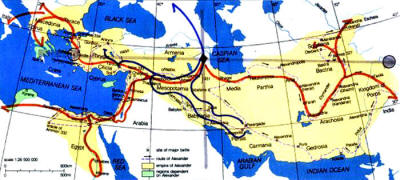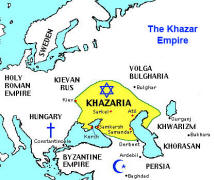Gnostics or Illuminati?
One the most daunting problems posed by the Gnostic Coptic materials is the question of origins.
Who wrote these documents, and where did the authors came from? It is exasperating to delve into this material with no concrete idea of its human origin in cultural, historical, or geographic terms.
Even assuming that the Egyptian codices are translations of “original writings” by Gnostics who belonged to cults scattered around Egypt and the Near East, we are left in bafflement as to where the Gnostic movement originated in the first place.
A Tangled Tale
The Nag Hammadi treatises are late scribal handiwork, poorly and erratically executed. They were copied down and translated — not written — by Coptic scribes using an improvised language. The desert monks who may have understood precious little of what they were translating. We do not know anything about the condition of the Greek texts they used, or why they were charged to make these translations.
This being so, my educated guess is probably as good as anyone’s: I’d say the “originals” were rough notes taken by students in the Mystery Schools, or what remained of them. The notes may have been translated into Coptic — in my opinion, a form of scribal shorthand or stenography, rather than a genuine language — as a writing exercise for the scribes, rather than to faithfully preserve the materials.
This is hard to imagine, perhaps, and painful to admit. But the awful fact is, these precious documents are appallingly shoddy, flawed, and incoherent.
We know where the Nag Hammadi codices were hidden, but not who put them there, or why. (On my notion that they may have been connected with the temple of Hathor at Dendera, a stone's throw from Hag Hammadi, see When the Mysteries Died.)
We have no idea where the originals may have been written and stored, but the Royal Library of Alexandria is one possibility. There is some artifactual and architectural evidence that Gnostic sects were established around the Mediterranean basin, including Palestine, close to the Dead Sea encampment of the Zaddikim.
The "originals" could have originated in hundreds of places.
Beyond the question of textual origins for surviving Gnostic documents looms the larger question of the origins of the Gnostics themselves? Scholars today ignore this problem as insoluble, and unworthy of their time. Their only take interest in the Coptic materials as they reveal something about the origins of Christianity, not Gnosticism. No serious scholar considers the content of Gnostic teachings and Mystery School instruction as such to be worthy of discussion. This disregarding attitude extends to the cultural, historical, and geographical origins of the Gnostic movement.
It was not always so, however. A hundred years ago, half a century before the Nag Hammadi find, scholars working on the Berlin, Askew and Ahkmin codices, and the paraphrases of Gnostic teaching found in the polemics of the Church Fathers (that is, the dossier of the prosecution), took a deep interest in the pre-Christian origins of the movement.
When Doresse published The Secret Books of the Egyptian Gnostics in 1958, there was still some debate over where the Gnostic movement originated. Amazingly, Doresse, a Catholic archeologist who was overtly hostile to the Gnostics, was the only post-Nag Hammadi scholar to cite what the Gnostics themselves had to say about the sources of their movement.
And thereby hangs a long and tangled tale.
The tale leads from Ephesus eastward past Hattusash, cold citadel of of the Hittites, and deep into Asia Minor: first to Harran, the bustling crossroads where Abraham arrived on the last leg of his exile from Ur in the Chaldees, then on to Ctesiphon, fabled for the soft heaps of amber in its marketplace, and into Parthia, home of the greatest archers in the world, past the scattered encampments of the Sabaeans, star-gazers who read in mystic trance the secrets of the thirteen heavenly Aeons, then deeper into Asia, beyond Nineveh, rich in courtesans, and beyond Hecbatana, smoke-filled city of a hundred gates, turning north toward the rugged Elbruz Mountains, and mounting to the high plain before Mount Hermon, the White Mountain of Seir, not far from the glittering, gunmetal blue of the Caspian Sea.
In plain English it leads to Azerbaijan, on the border of northwestern Iran.
There, bounded to the north by the Araxes River, a high plateau fed by Lake Urmia marks the geographic matrix of the Gnostic movement.
Doresse wrote:
“There we find legends anterior to Gnosticism — those, for instance, which attributed a sacred character to Mount Hermon, the supposed residence of the Children of Seth at the beginning of human existence."
(p. 255)
Once the homeland of the Gnostic movement is located geographically (black diamond, upper center of map), a remarkable fact comes to light: the Urmian Plateau was the hidden navel of ancient cultures in Mesopotamia, aligned to the Fertile Crescent and symmetrically uniting the Near and Far East with the Mediterranean.
See in below insert, enlarged view of map for more details.
by John Lash October 2006 from MetaHistory Website
The black diamond marks the Urmian Plateau, location of the White Mountain of Seir, geographical matrix of the Gnostic movement.
The gray cross situates this locale at the generative center of the entire region shown by the map. The vertical arms extend from Greece in the west to Ghandara in the east. The horizontal arm parallels the Fertile Crescent and, at its extreme extension south, marks Eridu, the ancient Sumerian port on the Arabian Sea.
From there the Zoroastrian Magi, later called Illuminati, spread southward and eastward (blue lines), setting up the first theocratic states. From the same point a different branch of the Magian Order, comprising the telestai or Gnostics as we understand them today, spread both east and west (brown lines), establishing the widespread network of the Mysteries.
The network of the Mysteries also ran westward across the southern rim of the Mediterranean Sea, toward Carthage. Note that the movement covered areas on both sides of the Dead Sea, i.e., Jerusalem and Qumran to the west, and Nabatea (modern Jordan) to the east, as well as the Negev Desert south of the Dead Sea, which was fertile down to the 3rd millennium BCE.
The Negev was called Seir in ancient times, due to the density of the Gnostic cults in that region.
Nearby was Catal Huyuk, a prehistorical Goddess-oriented society, an example of a non-theocratic culture in close proximity to a theocratic one. Catal Huyuk pre-dated the Hittites by millennia, of course. (Mellart says that the pre-urban, Goddess-based society of Anatolia "represents the climax of a process that must have started in the Upper Paleolithic, c. 35,000-10,000." The Archeology of Ancient Turkey, p. 22)
After 2000 BCE, theocratic tyrants run by the Magian priesthood imposed the patriarchal model more and more aggressively on surviving gylanic cultures. This is the period of the invasion of the Eastern Sea Kings, and, of course, the epoch of Abraham. (See R. A. Boulay, Flying Serpents and Dragons, Ch. 22.)
According to Steinerite prehistorian Gunther Wachsmuth (The Evolution of Mankind), Turanian culture was pathologically violent, its leaders bent on conquest by sheer force, whereas ancient Iranian culture was based on a pacifist model of agricultural society. He compares the Turanians to the blood-thirsty Aztecs of Central America.
Both cultures shared the same theology of split-source dualism, however. The cis-Caucasus was the ancient cultural and geographic matrix of the Ashkenazi Jews, a white Eastern European stock totally distinct from the Biblical Jews.
Turania was the remote origin, and "Khazaria" a later expression, of the brutal crypto-fascism of the New World Order whose ideologues and enforcers are often Ashkenazi Jews. In the NWO, Zionist politics and salvationist religion serve the master plan of domination in ways that have nothing to do with the genuine religious tradition of the ancient Hebrews and their true descendents, Sephardic Jews.
The Turanian-Khazar-Ashkenazi complex is the deep historical background of the Illuminati who operate through religious, political, and military manipulation in our time. One of their main ploys is Jewish conspiracy theory.
Icke's research suggests how the faux-Jewish Illuminati play both sides at once:
|
Star Wisdom
“Children of Seth” is the legendary name that Gnostics assigned to a sacred lineage of phosters, or revealers.
The name Seth occurs in the Bible, in Genesis 4:25:
“And Adam knew his wife again, and she bore a son, and called his name Seth. For God, said she, hath appointed me another seed instead of Abel, whom Adam slew.”
Significantly, this is the only time it occurs. Seth belongs to “another seed,” a lineage set apart from the Judeo-Christian narrative of “sacred history.” From the inception of their story, Gnostics are situated outside the conventional narrative of Western spiritual life.
By the Sethians' own account, a tradition of secret knowledge concerning divine matters was transmitted from remote times by a succession of men and women who had mastered the illuminist method, Gnosis. The Revealers were an elite corps operating within a unique cultural and spiritual complex that emerged in prehistoric Iran: the Magian Order (MAY-gee-un).
German scholars such as Gustav Widengren, Richard Reitzenstein, and M. H. Schraeder, who are largely ignored today, delved deeply into the prehistoric roots of Iranian religion known as Zurvan. This is the germ of the doctrine of cosmic duality attributed to the Persian prophet, Zoroaster, and spread throughout the world by the members of his religious order, the Magi.
Reitzenstein in particular intuited that Gnostic ideas were influenced by Persian duality, or Zurvanism, but he was unable to work out how. No one since his time has done any better. The investigation is complicated by the remoteness of Iranian religion, dating to the 6th millennium BCE.
Persian duality is the great enigma in the history of religions. So far no scholar in the world, not even Mircea Eliade, has cracked the Zoroastrian nut.
Zarathustra is said to have been older than Plato by 6,000 years. He learned universal wisdom from the Good Spirit, that is the excellent understanding. His name translated into Greek, Astrothutes, means “star-worshipper" (Plato Prehistorian, p. 211).
In his elegant little book on the Gnostics, Jacques Lacarriere asserts that Gnosis was a path of illumination based upon ancient star-wisdom. The Jewish historian Josephus says that the Children of Seth were widely revered as celestial seers who “discovered the sciences of the heavenly bodies and their patterns” (Antiquities, I.68-72).
All through the Near East and into Europa, the astronomer-priests of the Magian Order was known in late times as "Chaldeans," a rather misleading nickname. This term is a derivation of the Sumerian Kasdim, related to the Hebrew Chesed (a sepiroth of the Tree of Life) and Chassidim, "the pious," an ultra-conservative sect linked to the Zaddikim.
The tendency of Biblical editing is to conflate Chaldean motifs with the Magian Order, conferring legitimacy on the patriarchs by way of association. Abraham's father, Terah, was a priest of the temple of the lunar god, Sin, in the city of Ur. There is a great deal of astro-mythological lore encoded in the Old Testament — evidence of Magian and Sethian influences. And, of course, the Magi figure vividly in the New Testament fable of the birth of the savior.
A scribal note written on the margin of Alciabides I, a work attributed to Plato, attests to the legend that Zoroaster lived in the 7th millennium BCE. Several other classical sources, including Aristotle, Pliny, and Plutarch, also tell us that “the Magian,” lived 6,000 years before the death of Plato.
In her extraordinary and little-known book, Plato Prehistorian, Mary Settegast situates the rise of the Magian Order, the original priesthood of ancient Iranian religion, in the Age of the Twins, around 5500 BCE, a date supported by the Greek sources. Settegast refers here to Zodiacal timing based on the precession of the equinoxes.
The Age of the Twins, or Geminian Age, lasted from 6200 to 4300 BCE. The motif of duality associated with the constellation of the Twins is consistent with the central theme of Iranian religion, absolute cosmic duality, Good versus Evil. But this type of duality is not what we find in Gnostic teachings. In Not in His Image, I distinguish single-source duality from two-source duality (the two-source hologram of Philip K. Dick). The latter is typical of Gnostic writings.
In the Sophia mythos, there is no internal split in the Godhead (the Pleroma), but there is an anomalous projection from it, setting up a two-world scenario.
Most historians do not use Zodiacal timing to frame historical and pre-historical research, but Settegast does so outstandingly. Indologist and mythologist Alain 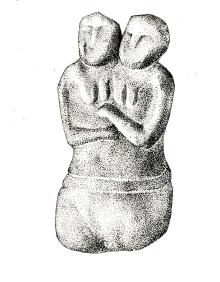 Danielou and cultural historian William Irwin Thompson also adopt this technique. I myself have applied it extensively for over thirty years.
Danielou and cultural historian William Irwin Thompson also adopt this technique. I myself have applied it extensively for over thirty years.
Reader take note: Plotting events by precession does not require adopting the belief that the stars affect human affairs. A Zodiacal Age is framing device, comparable to a geological age (Pleistocene), an historical period (Bronze Age), or a cultural epoch (Tang Dynasty). The framework of the Ages is an heuristic tool, not an astrological con.
Precession became legitimate in academic research in 1969, due to the publication of Hamlet’s Mill by Giorgio de Santillana and Herta von Dechend, but the book does not systematically apply precession to analysis of historical events.
Settegast uses precession deftly to coordinate ancient testimony on the Magian Order with archeological research, on the one hand, and historical-religious analysis, on the other. In my own researches with the master tool of precession, the Dendera Zodiac, I have found that Zodiacal Ages correlate to known historical and archeological evidences with impressive consistency, and often in astonishing detail.
Axis C of the Dendera Zodiac, dated to 5,600 BCE, marks the Age of the Twins. A white marble figure of the "double goddess" from Catal Huyuk VI (pictured on right, from Mellaart, The Archeology of Ancient Turkey, p. 21) clearly present the Twins motif.
At Catal Huyuk archeologists have found twelve successive layers of building, representing distinct stages of the city and reflecting different eras of its history. The top layers of the mound, containing the most recent buildings, are dated at 5,600 BCE, the date of Axis C and the double goddess relic.
I could offer dozens of similar examples....
Hidden Navel
Astronomer priests of the Magian Order and other skywatching seers from Hibernia to the Indus Valley would have used precessional timing to track the course of human experience over the long term. The Magi brought this method down from the Urmian Plateau and spread it throughout the Fertile Crescent.
At Eridu (Ur in the Chaldees), directly south from the hidden navel of the Gnostic movement, precessional timing would have been imparted to the first Sumerian theocrats. But once it was turned over to state-supported priests and social controllers of the early Near Eastern theocracies, precession lost its value as a tool for educational planning and guidance.
The telestai consecrated to guiding humanity fell into conflict with other Magians whose aims were political. The eventual split in the Magian Order devolved upon such arcane matters.
The period when the Gnostic movement emerged in prehistory is identified archeologically by the Hajii Firuz culture (5500 – 5000 BCE) of northwestern Iran and Turkmenia. It is centered on the Urmia basin, exactly where Gnostics located their spiritual hearth. The culture is named after an excavated site at the southern 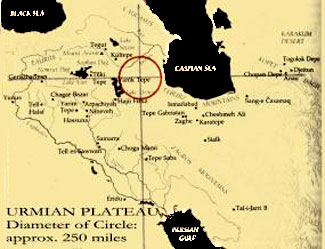 end of Lake Urmia, due east of Lake Van in Armenia.
end of Lake Urmia, due east of Lake Van in Armenia.
Over Lake Van looms Mount Ararat, where Noah’s ark is said to have come to rest. Over Lake Urmia looms Mount Kuh-I-Khwaga, the “White Mountain of Seir” held sacred by Gnostics down into a period some five or six thousand years after their tradition was founded there. (Map detail left, from Mary Settegast, Plato Prehistorian. Radius of circle, about 165 miles.)
A legend hinted in Coptic codices says that the Revealer lineage began at the Mountain of Seir with one illumined couple, Seth and his consort, Norea.
Mandaeans of the Iraq marshes, whose beliefs show many similarities to Gnosticism, recount a parallel legend of a founding couple, Anosh-Uthra and Yohanna, who established their base at the White Mountain. 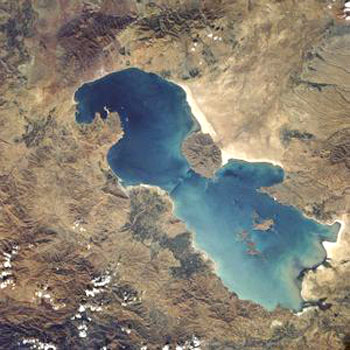 Seir is an Indo-Iranian root, cognate with Syr and Shri, “holy, hallowed, sacred.”
Seir is an Indo-Iranian root, cognate with Syr and Shri, “holy, hallowed, sacred.”
Urmia derives from the ancient Persian word for water.
Lake Urmia is an UNESCO Biosphere Reserve.
According to an ancient legend that survives locally to this day, the lakeside city of Urmia was the birthplace of Zoroaster.
“A very old Magian center was located at Lake Urmia,” Settegast writes.
(p. 215)
Some traces of this early settlement survive on the ground. Excavations at Hajii Firuz have produced rich archeological evidence, including a fired ceramic dish from the Halafian culture of Palestine, contemporary with it — i.e., the dish was brought to Urmia from Palestine.
The décor shows the sixteen petal motif, the signature of the Mystery cells. (Settegast, plate 121a.) It is likely that the organization of the Mystery cults in the Near East, as well as the technique and teaching they transmitted, derive from the remote Iranian matrix.
The Magian Order spread from the Urmia basin in all directions: northward into the Caucasus mountains, southward into Iraq, eastward toward India, and westward into Asia Minor and Europe. But as dissemination proceeded, the Order gradually split into two distinct branches, Gnostics and Illuminati, as we might now call them.
Each branch operated on different motives and methods.
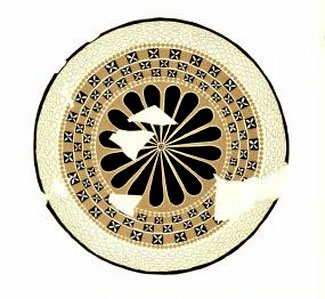
Masters of Learning
Iraniologists have found the problem of the Magi to be one of the most compelling, as well as one of the most difficult, in the history of the ancient world.
(Settegast, p. 215)
Within the Order, Gnostics were given the title of vaedemna, “seer, wise one,” as distinguished from the priest, the zoatar, who officiated openly in society and advised Middle Eastern theocrats on matters of statecraft and social morality, not to mention agricultural planning — for Zoroaster was by all accounts responsible for the introduction of planned, large-scale agriculture.
Iraniologists consider the problem of the Magi to be one of the most compelling, as well as one of the most difficult, in the history of the ancient world. I maintain that the problem can be elucidated, although not entirely solved, by distinguishing the Magians who remained committed to education and enlightenment from those who became involved in statecraft and social management —those later to be known as the Illuminati.
The Parsi word zoatar is the origin of the Greek word soter, “savior.” Judeo-Christian-Islamic tradition presents various permutations of the soter or redeemer figure. Redemptive religion, based on a superhuman agent who implements the will of the paternal deity, is termed soteriological. In Hebrew religion, this agent is the messiah, conceived either as a human person, the King of the Jews, or a superhuman entity such as Melchizedek (Zaddikim cult).
In Christianity, it is Jesus as the incarnation of Christ, the only-begotten Son of God, following the hybrid theology of Saint Paul.
In Islam, the redeemer figure is plural, assuming the form of various Imams and hidden masters. The Sunni-Shi'ite conflict is about the succession of Imans after Mohammed. In all cases the soter is a patriarchal figure, the central authority in a theocratic cult whose ultimate aim, make no mistake, is to dominate the entire world by imposing a social-spiritual order based on the dictates of an off-planet father god who speaks exclusively to white male demagogues (WMDs).
Persian soteriology is the origin of the One World Order shared today by neocon schemers and New Age fantasists alike. Over centuries, it produced the master plan of the Magians who went into social engineering, "the Illuminati," by contrast to the telestai or Gnostics who restricted their work to educational and spiritual guidance.
In the Coptic codices soter occurs frequently to designate the Gnostic master or teacher. But another term, phoster, is closer to the meaning of vaedemna, a wise or illuminated person (cognates: veda, vidya, wisdom, wit). Lest the reader despair, believing that I am unduly quibbling over terms, I must point out that a huge problem for humanity hinges on the difference between a seer and a priest, especially a state-sponsored priest.
Mary Settegast astutely notes that Iraniologists “hold conflicting views regarding the historical milieu of the prophet.”
The crucial problem is this:
At one extreme Zarathustra has been described as a primitive ecstatic, a kind of ‘shaman’; at the other, as a worldly familiar of Chorasmian kings and court politics.
(p. 215 ff)
Here is that distinction that has baffled all scholars: between the shaman-seer and the sacerdotal priest who plays a hand in court politics. For the latter, agriculture was part of a sacred vocation.
Since the cultivation of the earth was central to Zoroaster’s message,
“missionary priests would presumably have been as well-versed in agricultural technique as in religious dogma… Irrigation, fertilization, cattle breeding, would have been part of a missionary’s wisdom”
(p. 220)
Does this sound creepily familiar? In the mission of the Zoroastrian Magi who took control of social organization under the theocratic paradigm, we have the ancient model of invasive colonialism and all it entails, a model still in operation today.
Now consider the other side to the story.
According to scholarly opinion today and popular tradition in ancient times, the Magi were regarded, not as missionaries with a state agenda to execute, but,
“dedicated servants of the Gods” and “masters of learning, credited with initiating the ‘cosmological sciences,’ the study of not only the heavens, but the elements and kingdoms of earth”.
(p. 215ff)
Who are we describing here?
Missionaries or visionaries?
Enlightened emissaries of high culture or self-seeking colonialists?
Guides and Leaders
Within the limits of the present (long) article, I can do no more than introduce the issue of the Magi,
“one of the most compelling, as well as one of the most difficult, in the history of the ancient world,” as Mary Settegast observes.
This is not just a problem for scholars, however, it is a matter that concerns the very fate of humanity. It determines the way we view human potential and how we frame moral and ethical criteria by which society is guided. This long and tangled tale from northwestern Iran brings us to the core issue of human social experience: how we define what is evil, what works against life.
To summarize:
Gnostics came from the Magian Order, but, in some crucial way, they were at odds with it as well. The Gnostic movement identified by scholars through the Coptic writings from Nag Hammadi and elsewhere was a spin-off from the Magian Order, even a sort of defection.
The conflict within the Order was due mainly to two factors, one ideological and the other practical. Ideologically, Gnostic seers rejected the conflictual dualism of the Zurvan priesthood.
Reitzenstein and others who placed the origins of Gnosticism in Iranian duality did not have enough source material to recognize that Gnostic dualism is a two-world system, not a split-source system. By split source, I mean that good and evil come from the same source. Gnostics rigorously denied this view.
This is, however, the central Zoroastrian doctrine, inherited by an extremist sect of Palestine, the Zaddikim of the Dead Sea, and absorbed into Christianity like a lethal virus.
Today, delivering the State of the Union address, the American president relies heavily on the rhetoric of split-source dualism. We the good guys, them the bad guys. Gnostics considered that the problem facing humanity was not evil, but error. Absolute opposition of good and evil was an erroneous concept, and completely alien to their worldview. Gnostic ideas are wonderfully finessed, and their teachings are most finely nuanced when it comes to the problems of error and human responsibility.
One finds none of this sophistication in the rigid, conflictual dualism of Zoroaster.
On the second matter, the practical aspect, the “primitive ecstatic, or shaman” would and could not act as a political animal. Shamans are intermediaries between society and the Otherworld, the Unknown. The vaedemna does not enter into the politics of social control, not even to proffer advice, because he or she is consumed with other priorities.
For Gnostic seers, the priorities were to maintain the lineage of the Revealers, preserve the sacred method of instruction by the Divine Light, and teach and transmit what they knew to the world at large. They were consecrated to a sacred aim, a telos, that embraced two dimensions: the art of guidance and the work of culture-making. They did guide others, but they did not manipulate them in the way the zaotar or state-priest did.
They guided individuals by mystic instruction and the example of character. In short, they maintained a rigorous boundary between their consecrated aim, to teach, and the political ambition to lead. The best guides are not leaders. The best guides are like spies, who do not like to be followed.
As Dylan sang long ago,
"Don't follow leaders, watch ya parkin' meters."
Know-It-Alls
In his definitive study, “The History of the Term 'Gnostikos' ” (in Rediscovering Gnosticism; Proceeding of Conference at Yale - March 1978 ed.Layton), religious historian Morton Smith wrote that “gnostikos was not a common word.” He notes that respected initiates such as the Pagan emperor Marcus Aurelius did not use it. Neither was it common in Greek-language Judaism. It seems to have been used for the first time by Plato!
In the Politicus 258e-267a, Plato refers to gnostike techne, “the art of knowing,” or perhaps “the art of managing things known,” in order to argue that “the ideal politician is defined as the master of the gnostic art”. Plato asserts that “if such a being were to appear he would be a god come down to rule mankind.”
Well, there it is, as plain as day: Plato plays the deification card. His notion of a gnostikos is an expert advisor in theocratic government. i.e., rulership by the gods or those descended from gods. But how can this be. It is known that Plato was initiated at Eleusis. If he had intimate contact with telestai, how could he have embraced and endorsed the program of the Illuminati, the Magians who run the theocratic agenda?
I would suggest that the answer lies in well-known analogy of Plato's Cave. According to this metaphor, objects in the sensory world are mere shadows cast by the Eidos, the divine Forms in the supersensory realm. But the Organic Light casts no shadow. I conclude that Plato, though initiated, never witnessed the Organic Light, the secret medium of Mystery instruction. Had he done so, he would never have invented the analogy of the Cave.
A fragment of Plato's manifesto of Illuminati statecraft, The Republic, is found translated into Coptic at Nag Hammadi (Codex VI, 5).
This is the oldest text in the NHL, dating to almost 700 years earlier than the other documents. Yet no scholar has remarked on the highly unusual fact of its inclusion into the corpus.
I have pointed out before that the guardians of the Mysteries did not call themselves gnostikoi, but telestai, "those who are aimed."
It is known that gnostokoi was the term directed at them in ridicule by the Church Fathers: "smart-ass, know-it-all." I maintain that the telestai renounced this name because it was associated (via Plato) with the social engineers and special advisors of theocracy.
It is significant that the sole instance of a Gnostic sect known to have called themselves gnostokoi was a group of Carpocratians led by a woman named Marcellina. The Carpocratians tended to embrace the Hindu doctrine of avataric descent, i.e., flesh-and-blood embodiment of superhuman beings — an element of the theocratic scenario.
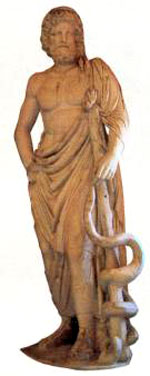 The group led by Marcellina,
The group led by Marcellina,
"had pictures and statues of many great teachers who were held in honor by their school, such as Pythagoras, Plato, and Aristotle, and also a portrait of Jesus," according to the report of Origen.
(G. R. S. Mead, Fragments of a Faith Forgotten, p. 232ff)
The cult of personality was totally incompatible with the mission and demeanor of the telestai. They would never have tolerated such statues, but glorification of "great men" is typical of the theocratic agenda.
The telestai maintained anonymity within their role as mystics and guardians of the Mysteries, although as teachers working openly in society, they of course had names and social identities. In other words, they did not parade their connection to the Mysteries for social standing or prestige. The names ascribed to Gnostics and initiates were actually titles rather than proper names: Asklepios (Aesculapius), for instance.
The names of very few Gnostics - Simon Magus, Valentinus, Basilides, Hypatia - have come down to us.
" The kindly old gentleman with the wise and benevolent snake" is an archetype or icon of a telestes, not a real-life portrait.
"Statues of Christ have sometimes owed something to statues of Asklepios. The consort of the physician was Health (Hygeia)... As for the snake, he is the most important person in the sanctuary."
Statue from Epidauros, Roman period. Atlas of the Greek World, p. 162
Today we use the insult "Gnostic" to characterize the ancient movement whose members opposed, not only their own self-glorification, but the theocratic program of great men and male leaders established and enforced by the politically oriented Magians.
Conclusion
Theocracy, the prototype of patriarchal rule, is the trump card of the victim-perpetrator game, as I explain at length in Not in His Image. If the tyrant who afflicts and rewards his people can convince them he is appointed to do so by god, or that he himself is a god, then divine authority rules the day (as Constantine, the faux convert, understood so well).
But theocracy, and the entire dominator complex it focalizes, was totally alien to the telestic mission to teach, enlighten, guide, enrich — in short, to encourage and cultivate human potential. The will to control and manipulate human potential can never be reconciled with such a mission. This is why the original Gnostics, adepts of shamanic ecstasy who taught from instruction by the Light, defected from the Magian Order.
The Order around in the Urmian Plato in the Age of the Twins, around 6000 BCE. The split devolved after 4400 BCE, when the vernal point was shifting from the Bull into the Ram.
The Age of the Ram (c. 2000 - 120 BCE) is the era of Abraham and the rise of patriarchy, including the Roman Empire. Alexander the Great ruled the ancient world when the spring equinox was located in the head-stars of the Ram, known as Amun to the Egyptians.
Consequently, Alexander had himself pictured on coins with the horns of Amun, and he staged an initiation at the Amun sanctuary of Siwa with the purpose of having himself elevated to a god-like status (yet another example of historical and artifactual verification of precessional timing). All this is totally consistent with the advancement of theocratic agenda in the Arien Age.
From their ancestral ground in the northwestern Iran, Gnostics would have been able to observe developments in the Fertile Crescent, including the rise of mass-scale agriculture and urbanization.
Their status as nomadic sages, the famous “Chaldeans” of antiquity, would have given them every advantage to observe three momentous developments:
the shift from the sacrificial king (primary scapegoating, the pharmakon method)
to the sacred king (modified rite, requiring the hieros gamos, sacred mating with the Goddess, to assure the human worthiness of the king )
to the redeemer king (men anointing men, and to hell with sacred mating)
They could not have closely analyzed this progression, not detected the pathological violence driven by redemptive beliefs as deeply as we can, however. At least, I don’t think so.
The sheer force of it may even have taken them by surprise, not to mention the insidiousness of Illuminati techniques, perverting the regenerative rites of the Mysteries....

View of Lake Urmia with salt crystals and island
(Photo by Ehsan Mahdiyan)
We are at the other end of the long drama that began by the shore of Lake Urmia, with 2000 years worth of hindsight on the Illuminati program and what the message of divine love packaged in the redeemer complex can do to life on a small, lonely planet.
This article is taken from Biblioteca Pleyades - a recommended source of all kinds of interesting reading. This article does not necessarily represent the views of the Temple or it's founders.
Tags:
Replies to This Discussion
-
Permalink Reply by 22vkvs27ucy3h on January 27, 2011 at 9:05pm
-
Everything I wrote as a reaction to the earlier post ( "Is Buddhism All it's Cracked Up to Be") is applicable here.
The twists and turns of the Gnostics and the Illuminati excite and inspire me much more than the channelings, although the link and relevance to each other is quite easy to make.
Thanks again, Leila, for this wonderful post.
-
Permalink Reply by Leila Raven on January 28, 2011 at 4:07pm
-
Kelly, I was raised in an atheist household, but with very intelligent informed parents, they didn't believe in God, but even then it was believed by historians Jesus was an actual person.
I took Religious studies in university, and the class Hebrew Myth covered the bible and Jesus. It is commonly agreed on by most scholars that Jesus was indeed a real historical figure, who lived, walked, breathed, and preached. That part is pretty certain, as far as we can be certain of any history. It is however commonly accepted in belief, even by non-religious atheist scholars, that Jesus was a real man. What most don't agree on is if he is son of 'God'.
There are definitely wisdoms to be found in his words.
-
Permalink Reply by 1hunby5xt8o0f on January 30, 2011 at 9:27pm
-
Very interesting reading, Leila. Thank you for sharing.
-
Permalink Reply by 0s9jkgx8sr3l0 on February 2, 2011 at 5:42pm
-
(warning .. the stuff below is kind of a rambling tangent going off from the main point of the thread ..)
I consider myself "gnostic" (with the emphasis on the little "g"). I use that word to signify that my knowledge emerges from within. Ie. i make it up as i go along (according to what i stumble upon) without a feeling of alignment with any particular disciplined .. umm .. can't think of the word. Anyway .. it's more fun that way.
I gotta say, i find the historical stuff about Gnosticism interesting but incidental. There's too much sense of religion about it. It seems to hint that truth can be passed by word and teaching. But that's not what gnosis is really about is it? "Truth" can't be communicated. (i guess you must realise i'm inventing this as i go along). We are all beings in existence. We have all the same connection with reality. That's our source of gnosis .. erm .. in my opinion .. anyway .. about historical ideas about Gnosticism .. we're an alien society .. can we comprehend the meaning behind what was said, even though we understand the words?
eg. the stuff about "good" and "evil". These are tags. We use them to represent particular ideas. When we think of "good" and "evil" we think in terms of "malevolent" and "beneficial". But did they always represent those same ideas?
Take the story about adam and eve in the garden of eden. Adam and Eve ate the fruit of the tree of knowledge of "good" and "evil". Then they were banished from the garden of eden. My instinct tells me, in this case "good" and "evil", rather than representing "benevolent" and "malevolent", represent generic complements. The terms might as well have been "yin" and "yang". Adam and Eve, in the garden of eden were in a state of bliss - where the world is unity - where existence is being and not perception. However, to have knowledge of "good" and "evil" meant they now can now perceive the world - they see the world in terms of complementarities - as all we mundane humans do. Perception is borne out discrimination of yin-yang. Therefore, the act of having knowledge of "good" and "evil" *is* the banishment. Perceiving the world is to be outside and no longer *be*. The "god" who banishes here is an abstract figure that represents the laws of nature.
.. erm .. sorry .. i seem to have drifted. What were we talking about?
-
Permalink Reply by 2yk241cmanwv7 on February 28, 2011 at 12:13am
-
*BUMP*
Very informative!
-
Permalink Reply by 308tiid2c9u25 on February 28, 2011 at 5:28am
-
Excellent article Leila - so informative. To understand the source of secret knowledge it's necessary to go back to the first authored literature in the world, the Epic of Gilgamesh, transcribed into cuniform around 3000 BC but doubtlessly containing a particular format that had existed for a few thousand years previously, passed down and maintained by verbal memory chant by the media moguls of the time, the storytellers ... and probably changing the name of the main character to stroke the ego of the tribal overlord of the period.
So what is the Gnosis? What is the knowledge that so many have sought over the years? Why must it remain a mystery? What possible damage could occur if more people knew the truth - loss of power maybe? The same question can be asked of the grail (gradale), why would such a "holy" artefact be hidden if it could substantiate biblical claims - once again, loss of power maybe?
I realise the time span between those two questions is immense, but they are specifically linked.
The Epic of Gilgamesh is a fantasy woven around the prehistoric constellations that were in operation before the 12-house version that we all know today. Originally it was merely a memory chant, recalling tribal origins, measurements, geography and the cosmos-based social system that existed in the time of their ancestors from a far-away land. It was a mixture of sun worship (the annual journey around the ecliptic circle) and moral fortitude.
The epic can be likened to the rhyme "30 days hath September" or the celebrated memory-men of today who can recall the order of a deck of cards by constructing a visual/allegoric tale that references the individual suits and values of each card, allowing them to recall and repeat the order perfectly at a later date. It is the main method now, it was the main method then, very little has changed.
However, over time and maybe with the onset of writing, the original reason for the epic became tainted and misused. Storytellers were more interested in the effect of their work on others than the reason for its existence, in fact so many centuries had passed that many were probably ignorant of the origins - if you could read, you had status, you were in demand, and life was easy. I think this is a good point in time to stop calling them storytellers and start calling them the priesthood (hello religion!).
It is also a good time to explain that the Epic of Gilgamesh is based upon the graphic of the Malvern Zodiac, situated in central England. Don't ask me how it travelled to Sumer, I have no idea. I think it's fair to refer to Gilgamesh as the first hero in a long line of "heroic" literature that was to follow - the method of weaving a fantasy around these unique constellations continued unabated.
It is possible to identify a heritage within the consequential stories that followed over the next 3000 years, many of the allegoric references are repeated or added to. The Epic of Gilgamesh is a reasonably simple, easy-to-follow version of the sun's annual journey, but Homer's Iliad or Appollonius' Argonautica (both based upon the Malvern Zodiac) are considerably more detailed and convoluted.
One particular ancient text is my favourite, The 12 Labours of Heracles. It explains the transition from the ancient Malvern Zodiac to the (modern?) 12-house zodiac. Each individual task is designed to move (or remove) one of the old constellations and replace it with the new.
Furthermore, for any budding archaeologists out there wishing to visit Thermopylae, I really wouldn't bother. There may well have been a battle at Thermopylae ... but it wasn't the Battle of Thermopylae ... if you know what I mean. The story is also based upon the Malvern Zodiac.
Maybe I should hasten to the "big one" - Christianity, but I guess you already know where this is going. Okay, so the story itself is a complete falsehood, a continuation of the storytelling heritage, from wondrous star (Vega) to the crucifixion ... however, I am not complaining, because every time I see a crucifix I know that it represents the Dragon constellation of the Malvern Zodiac and by realising that I stay in touch with the ancestral thought process. Deities are not important, but our place in the cosmos is. They knew that way back when ... and the answer to that is 9600 BC.
Have I rambled too much? It's a failing that I have.
-
Permalink Reply by 308tiid2c9u25 on February 28, 2011 at 10:18am
-
Just adding a short coda to the previous reply - extra thanks to Leila for filling in so many blanks that I had mentally skirted over during my research (I get easily distracted) - especially the way the gnostic information spread geographically and tribally across from the early near east delta, invaluable stuff. I had always understood this to be the case, but never delved as deeply and as detailed as that.
I have often been told to explain things more slowly, that others will not understand. It's difficult, I've been living and breathing with such a "porridge" of information in my head for many, many years - I forget that others often need time to divulge the overview.
On the subject of Malven Zodiac constellational allegory - there is a small Youtube example concerning heroes at http://www.youtube.com/watch?v=1C7kfjtZU6w - it may help to explain further.
-
Permalink Reply by Leila Raven on February 28, 2011 at 10:33am
-
I know I posted the article for a reason. *smile* When I came across it, it filled it some gaps of understanding for me, I'm glad others are getting good information and understanding out of it as well.
Have questions?
Need help? Visit our Support Group for help from our friendly Admins and members!
Have you?
Donations & Sponsorship
Connect
Visit The Temple
on Facebook:
Blog Posts
PRINCIPALITIES & POWERS - DOMINIONS & THRONES - 36 DECAN MNEMONICS
Posted by FRA .*. DISTURABO .*. on September 27, 2025 at 11:11pm 0 Comments 0 Likes
390 - LIBER 220 - 1:57
Posted by FRA .*. DISTURABO .*. on September 27, 2025 at 7:35pm 0 Comments 0 Likes
PHOENICIAN / VALUES
Posted by FRA .*. DISTURABO .*. on September 26, 2025 at 4:05pm 0 Comments 1 Like
The Atlantean
Posted by Heth Lee (李) on September 25, 2025 at 6:30am 0 Comments 0 Likes
Channeled Angelic Wisdom of the Jewels of Truth Series on Astral Holy Light & Sound and Binary Dominion Inversion
Posted by Atrayo on September 25, 2025 at 1:05am 0 Comments 1 Like
StatiCal: Exodus
Posted by Heth Lee (李) on September 20, 2025 at 7:00am 2 Comments 0 Likes
RUDOLF STEINER 1917 QUOTE & LINKS on >The Fall of the Spirits of Darkness
Posted by FRA .*. DISTURABO .*. on September 17, 2025 at 8:00pm 0 Comments 1 Like
Boy Wonder
Posted by Heth Lee (李) on September 17, 2025 at 4:30am 0 Comments 0 Likes
אדוארד אלכסנדר קראולי - EDWARD ALEXANDER CROWLEY / 928 - 1440
Posted by FRA .*. DISTURABO .*. on September 16, 2025 at 1:12am 0 Comments 0 Likes
Temurah - 424 - 516 - 86 (תְּמוּרָה) 651
Posted by FRA .*. DISTURABO .*. on September 12, 2025 at 6:30pm 0 Comments 1 Like
4638 ABK 24 ALGMOR 3YX 24 89 RPSTOVAL
Posted by FRA .*. DISTURABO .*. on September 12, 2025 at 5:00pm 0 Comments 0 Likes
2106 ••• SOME INTERESTING ENGLISH GEMATRIA
Posted by FRA .*. DISTURABO .*. on September 11, 2025 at 7:00pm 0 Comments 1 Like
359
Posted by FRA .*. DISTURABO .*. on September 11, 2025 at 4:30pm 0 Comments 1 Like
Channeled Angelic Wisdom of the Jewels of Truth Series on Cascading Blessings, Energy Healing, and The Seven Orders of Karma
Posted by Atrayo on September 11, 2025 at 12:19am 0 Comments 1 Like
The Drac: The Blue Album
Posted by Heth Lee (李) on September 11, 2025 at 12:00am 0 Comments 0 Likes
The 3i/ATLAS
Posted by Heth Lee (李) on September 8, 2025 at 2:00pm 0 Comments 0 Likes
TEMPLE ILLUMINATUS / מקדש אילומינטוס
Posted by FRA .*. DISTURABO .*. on September 7, 2025 at 8:30pm 1 Comment 1 Like
POWER!
Posted by Rosey Cross on September 7, 2025 at 4:57pm 0 Comments 0 Likes
ABOVE!
Posted by Rosey Cross on September 7, 2025 at 4:54pm 0 Comments 0 Likes
SEAL SIGNET -vs- CATTLE BRAND
Posted by FRA .*. DISTURABO .*. on September 3, 2025 at 4:30pm 0 Comments 0 Likes
NOVEMBER AWARENESS
Videos
© 2025 Created by Bryan
Powered by
![]()
